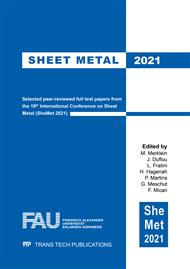p.97
p.105
p.111
p.119
p.127
p.135
p.143
p.151
p.159
Numerical and Experimental Fracture Mechanical Investigations of Clinchable Sheet Metals Made of HCT590X
Abstract:
In many areas of product manufacturing constructions consist of individual components and metal sheets that are joined together to form complex structures. A simple and industrial common method for joining dissimilar and coated materials is clinching. During the joining process and due to the service load cracks can occur in the area of the joint, propagate due to cyclic loading and consequently lead to structural failure. For the prevention of these damage cases, first of all knowledge about the fracture mechanical material parameters regarding the original material state of the sheet metals used within the clinching process are essential.Within the scope of this paper experimental and numerical preliminary investigations regarding the fracture mechanical behavior of sheet metals used within the clinching process are presented. Due to the low thickness of 1.5 mm of the material sheets, the development of a new specimen is necessary to determine the crack growth rate curve including the fracture mechanical parameters like the threshold against crack growth ΔKI,th and the fracture toughness KIC of the base material HCT590X. For the experimental determination of the crack growth rate curve the numerical calculation of the geometry factor function as well as the calibration function of this special specimen are essential. After the experimental validation of the numerically determined calibration function, crack growth rate curves are determined for the stress ratios R = 0.1 and R = 0.3 to examine the mean stress sensitivity. In addition, the different rolling directions of 0° and 90° in relation to the initial crack are taken into account in order to investigate the influence of the anisotropy due to rolling.
Info:
Periodical:
Pages:
127-132
Citation:
Online since:
April 2021
Authors:
Keywords:
Price:
Сopyright:
© 2021 Trans Tech Publications Ltd. All Rights Reserved
Share:
Citation:


